|
Computers
are fast, can't be corrupted, are immune to nepotistic tendencies,
and treat all users the same. That's a chorus India's e-governance
brigade has adopted as its own. It is also a fairly accurate statement:
the efficiency and transparency promised by e-governance present
a sharp contrast to the bureaucratic morass governance in India
has come to be.
Not all e-governance initiatives have worked.
Many remain on paper. India's politicos, it would appear, are no
different from entrepreneurs who believed merely appending dotcom
to the names of their businesses would make their fortunes. Some
initiatives work, but with key modules offline, the purpose of the
exercise is lost. And still others work and live up to the promised
levels of efficiency and transparency, but the objective is inconsequential
enough to be dismissed outright.
This isn't a survey of India's best e-governed
state. Nor is it one of those touchy-feely articles on e-governance
one has come to expect to see in the country's magazines and newspapers-compositions
written in the expectation of things to come, in the hope that ambitious
blueprints drafted by laptop-toting chief ministers and their willing
corporate advisors will, one day, result in some real activity on
the ground.
This article is a compilation of experiences.
Our correspondents sampled, first hand, the e-governance efforts
of six states: Andhra Pradesh, Tamil Nadu, Karnataka, Gurgaon, Delhi,
and Maharashtra. In each case, they tried to accomplish something
online-even if it were something as mundane as renewing a driving
licence or acquiring a certificate of domicile. Maybe, just maybe,
e-governance is actually about such things than lofty vision statements
and loaded-with-irrelevant-information government websites.
 |
| A
SETU touch-screen: Watch your
files |
Maharashtra
The Box Rules
E-GOVERNANCE SNAPSHOT: The I-SETU project;
the Koshwahini project linking 33 government treasuries and 292
sub-treasuries to handle annual transactions of around Rs 70,000
crore; computerisation of land records and municipal corporations
FIRST E-GOVERNANCE INITIATIVE: SARITA
(Stamp Duty and Registration with IT Application) in August 2000
I meet a surprised-looking
Mukesh M. Barve at the Thane District Collectorate's SETU (Society
for Promotion of Excellence and Transparency in Public Administration
for Better Understanding of Requirements of Citizens in Their Interface
With Government-phew!) centre. He is clutching a domicile certificate
in his son's name-the boy is appearing for an entrance test to the
state's medical colleges and he needs the document. Barve is a doctor
himself, and still remembers the day in 1976 he visited a government
office to obtain a similar certificate. It had taken him a month
and a bribe of the then princely amount of Rs 10 to effect the transaction.
Now, it had taken him a little over two hours-the required data
had been keyed in earlier that morning after he filled out a form,
the tehsildar had cleared the file online, he had been able to monitor
the progress of his document online through a touch-screen, and
here he was, 135 minutes later, with the certificate in his hands.
"Check out the other Tehsildar's office near by," whispers
Barve. I do; it isn't computerised, and there is no one there. But
in most districts of Maharashtra, it is possible to obtain basic
certificates related to birth, death, marriage, domicile, solvency,
and income from SETU centres. The Thane Collector's office has issued
some 30,000 such certificates in the past 18 months. Watch out for
the I-SETU network, linking individual centres, the state's it Secretary
Mukesh Kulla tells me, and watch out for the 50 centres that Mumbai
itself will soon have. "The intent," he says, "is
to enable delivery of services to citizens anytime, anywhere, and
anyhow."
-Dipayan Baishya
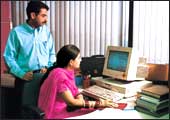 |
| The
Khannas : Real-world match, online
registration |
Delhi
Not just yet
E-GOVERNANCE SNAPSHOT: Downloading forms
for the issue of ration cards, certificates and licences; online
grievance submission facility
FIRST E-GOVERNANCE INITIATIVE: Computerisation
of the issue of driving licences in 1994
I am looking forward
to experiencing Delhi's e-governance efforts from the air-conditioned
comfort of our office. Colleagues in Hyderabad and Bangalore had
been forced to visit e-kiosks to experience their state's e-efforts,
but surely, I think, www.delhigovt.nic.in will save me a similar
fate. The site is replete with information of the how-to sort concerning
applications for certificates (birth, death, marriage), and the
forms can be downloaded, but I find out that I have to present myself
at the specified office to complete the transaction. Concerned,
I speak to a government executive and he tells me that by visiting
dcwestrev.delhigovt.nic.in, I can submit a request for marriage
registration online (now, how will the average citizen get to this
page?). "Don't worry," my informant tells me, "you
can submit other forms online in a fortnight." Being single,
I decide to speak to someone who has recently done the registration
thing online-five marriages have been registered online thus far.
I manage to meet with Rajesh Khanna, a social scientist who managed
a marriage registration certificate on March 31, four days after
his application. Only, he had to lug along a gazetted officer and
a ton of documents to the centre. At the centre, a tout tells me
he can have a certificate home-delivered for Rs 5,000, no questions
asked.
-Vandana Gombar
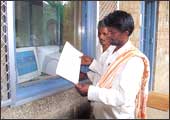 |
| A
Bhoomi beneficiary: Look,
Mom, my own land record |
Karnataka
The Bhoomi Story
E-GOVERNANCE SNAPSHOT: Computerising
admission to colleges; the Khajane project linking treasuries of
27 districts; and computerisation of rural land records (Bhoomi)
FIRST E-GOVERNANCE INITIATIVE: CET (Common
Entrance Test) computerisation in 1994
A sudden shower
ensures that my colleague, the photographer, and I reach the Karnataka
government's land records office in the central Kempe Gowda Road
a little wet. This is the setting for Bhoomi, the computerised land
records project of the S.M. Krishna government that won a Commonwealth
award in 2002 and serves as the Union Government's template for
similar projects. For the record, Bhoomi kiosks have mushroomed
in 177 administrative blocks of the state and records of 6.7 million
farmers have been digitised. At this kiosk, I run into a disorderly
queue of farmers, landlords, and the ubiquitous hangers-on. As my
colleague whips out his camera, we are recognised as journalists.
The counter clerk wants to know which publication we represent,
but before I can answer we are mobbed by farmers wishing to be heard.
"By computerising these records, the government has helped
us obtain land records easily," says Doddathogur Raja (actually,
he says, "by putting the computer here", but this is what
he must mean) who is here to collect title documents for land he
has just divided with his brother. He goes on to describe how the
computerised process is quicker and corruption-free. "The Tehsildar
and revenue officers used to act like kings," pipes in another
farmer. "Now, no one even serves them coffee when they visit
our villages." It is clear that Bhoomi has its glitches. Chikkathima,
a farmer from Uttarhalli Hobli says his record has a mistake. The
clerk says there are some errors that have crept in while transcribing
hundreds of thousands of written records and expresses his willingness
to rectify this specific mistake. The Krishna government has been
accused of focusing on urban issues; it must be hoping the farmer-oriented
Bhoomi can ensure some returns at next year's elections.
-Venkatesha Babu
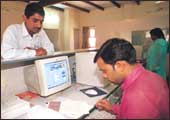 |
| Haryana's
e: Mere printouts? |
Haryana
Promises
E-GOVERNANCE SNAPSHOT: Computerisation
of land records; web-enabled electoral rolls; online passport enquiry
FIRST E-GOVERNANCE INITIATIVE: HARIS
(Haryana Registration Information System) in 2000
I was taken in
with Haryana's website, www.haryana.nic.in. Its land records site,
www.jamabandi.nic.in, for instance informed me that I could obtain
a RoR (Record of Rights aka Jamabandi in the vernacular) easily.
So, here I was at a land record office in Gurgaon only to find out
that the records are being updated. "Don't worry," I was
told, "the process will be completed in the next 15 days and
free RoRs issued to residents of 10 villages." There are 734
villages in all in the Gurgaon district, and this promise of free,
and in the future, set my spider senses tingling. True, several
of the Haryana government's departments are 'computerised', but
few are linked to each other, and web-enablement seems a distant
dream. Still, I found out that I could obtain computer-generated
certificates for everything from birth to death to vehicle registration.
And yes, I could post my grievances online-perhaps the only thing
that can be accomplished without visiting a government office.
-Vandana Gombar
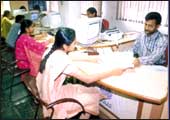 |
| eSeva:
Serving citizens Naidu-style |
Andhra Pradesh
Over The Counter Heaven
E-GOVERNANCE SNAPSHOT: eSeva centres
offering a wide range of services to citizens in parts of Hyderabad
and Secunderabad; CARD offering computer-aided registration services;
Saukaryam offering online civic services in Vishakhapatnam
FIRST E-GOVERNANCE INITIATIVE: CARD
in 1998
I am in the eSeva
centre at Greenlands, Hyderabad's central business district. In
the room abutting the hall I am in are seven counters symbolising
Andhra Pradesh Chief Minister Chandrababu Naidu's e-governance efforts.
Since its launch three years ago, the services offered by the 30
eSeva centres in Hyderabad and Secunderabad have become reasonably
popular.
I have two tasks on hand: to renew a driving
licence and pay my electricity bill. The second is easy, but my
expectations regarding the licence-after all, one was issued within
minutes to then US President Bill Clinton during his visit to a
eSeva centre in 2000-are soon shattered. "You will have to
go to the Banjara Hills centre," I am told. BH, for those who
don't know, is the city's most posh borough. I needn't have bothered.
"Go to the Khairatabad centre," I am told at BH. Still,
is that reason enough for the Comptroller and Auditor General of
India's just-released report for 2001-02 that finds the project
"suffering from lack of transparency, inefficiency, and ineffective
implementation"?
-E. Kumar Sharma
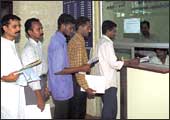 |
| e-gov
in Chennai: Registering transactions
online |
Tamil Nadu
After April 10th
E-GOVERNANCE SNAPSHOT: Computerisation
of land records, small-scale industries department for the issue
of SSI registration certificates, and Tamil Nadu Medical Services
Corporation for e-procurement of drugs
FIRST E-GOVERNANCE INITIATIVE: Computerisation
of Thanjavur district administration in 1997
The it secretary
of a state that boasts India's first e-district-Thanjavur in 1997-must
be plagued with work. He has no time to meet with me, can't speak
on the phone, and when I send him an e-mail (at his request), there
is no response.
Thanks to the information-loaded website of
the Electronics Corporation of Tamil Nadu (ELCOT), I find out the
two most promising subjects for my experiment: the office of the
Inspector General of Registration, the oldest department in the
state (it was created in 1875); and the Road Transport Office.
I hit the sub-registrar's office at Santhome
having decided to try and obtain an encumberance certificate for
a property owned by a relative; the office also issues marriage
certificates, offers valuation guidelines for property, and registers
documents. A clerk takes my filled out form, keys it into a pc and
tells me, "You can do this online at your convenience and then
follow up with a visit to any sub-registrar's office-all offices
are networked." Exactly 24 hours later, a courier hands me
the certificate and takes Rs 125 in return. It's efficient, but
there don't seem to be too many takers-in the last six months, a
mere 306 of the 7,474 certificates handed out in Chennai had their
origin online. Maybe that's because of a lack of awareness.
Emboldened by my first experience, I call the
RTO in East Coast Road (that's the area I live in) to find out how
to renew my driving licence. "Renewals only after the 10th,"
says a voice at the other end, "but if you want more advice,
please come to the office after 4.00 p.m." I go. At the office,
confusion reigns supreme. Three of the four computers are not being
used. The RTO (Road Transport Officer) steps in to assist; I will
need to fill in a couple of forms. And nothing can be done online.
"Form-filling and submission has to be done as usual madam,"
he smiles pityingly at me. "But you will get a printout of
your licence from the computer." April 10th, I await thee.
-Nitya Varadarajan
|

